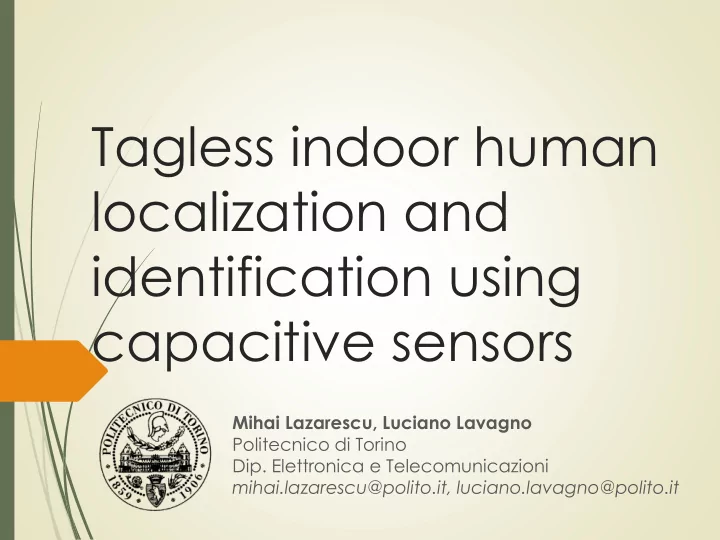

Tagless indoor human localization and identification using capacitive sensors Mihai Lazarescu, Luciano Lavagno Politecnico di Torino Dip. Elettronica e Telecomunicazioni mihai.lazarescu@polito.it, luciano.lavagno@polito.it
Contents 2 Rationale for long-range capacitive sensing Measurement of small capacitance variations Human localization using ML classifiers Conclusions Italian Workshop on Embedded Systems (IWES) Rome, September 7-8, 2017
Why long-range indoor 3 capacitive sensing? Indoor human localization and identification can enable many automation and monitoring apps Long-range load-mode capacitive sensors are small, inexpensive, easy to install and operate Generally low accuracy and low range Low noise measurement techniques (C ~ A / d 2÷3 ) Sensor data post-processing: Improve SNR (ΔC < 0.01%) Infer human location and behavior Italian Workshop on Embedded Systems (IWES) Rome, September 7-8, 2017
Measurement challenges 4 Planar capacitors with √A >> d C = ε A / d Load- mode capacitors with d >> √A C ~ A / d 2÷3 d (meters) >> √A (tenths of cm): Very low ΔC (< 0.01%) Very high measurement sensitivity Low noise sensitivity Good noise rejection Italian Workshop on Embedded Systems (IWES) Rome, September 7-8, 2017
Base band measurement: 5 charge-to-voltage => freq. C = Q / V Control Q flow, set V thresholds Measure f ~ 1 / time-to-V threshold Simple, cheap, low-power Low C, low I for kHz-range f (lower quantization noise) Very high impedance input Susceptible to EM noise (V noise => f jitter) Difficult noise filtering Low SNR overall Italian Workshop on Embedded Systems (IWES) Rome, September 7-8, 2017
Carrier modulation: 6 phase and amplitude V diff correlated to carrier amplitude and phase shifts due to X Cs changes Effective carrier noise filtering (stable known frequency) Output signal can be amplified before measurement (lower quantization noise) Overall improved SNR and sensitivity Italian Workshop on Embedded Systems (IWES) Rome, September 7-8, 2017
Carrier modulation: 7 phase Vdc correlated to carrier phase shifts due to X Cs changes Carrier noise can be filtered well Output can be amplified Improved SNR and sensitivity Italian Workshop on Embedded Systems (IWES) Rome, September 7-8, 2017
Human identification 8 Measure the body-sensor capacity at several frequencies at (almost) the same time Capacity-frequency dependency pattern depends on body properties (tissue ratios, shape, …) Distinct patterns can identify persons from limited pool Monitor passage through doors Italian Workshop on Embedded Systems (IWES) Rome, September 7-8, 2017
Localization using machine 9 learning classification Room localization experiment using ML classification and the “noisy” sensors Train k-NN, Naïve Bayes, SVN to classify 16 room locations using sensors of different sizes Test algorithms classification accuracy Naïve Bayes performed best, especially for the largest sensor size (16 x 16 cm) 4x4 cm 8x8 cm 16x16 cm Italian Workshop on Embedded Systems (IWES) Rome, September 7-8, 2017
Performance of machine 10 learning localization (1) Same room, same sensors, but: Data acquired using different body angles Acquisitions weeks or months apart Tested performance of most (48) Weka collection algorithms Training using with different set sizes Testing with unseen data sets Performance measurement Accuracy, error, precision, recall, train effort, classification effort, memory requirements Italian Workshop on Embedded Systems (IWES) Rome, September 7-8, 2017
Performance of machine 11 learning localization (2) Italian Workshop on Embedded Systems (IWES) Rome, September 7-8, 2017
Using advanced machine 12 learning algorithms Classification (1 out of 16 locations) has a significant quantization error (15cm on average with 60cm grid) and may not be suitable for all applications Can use neural networks to directly convert sensor outputs to (x,y) location within room, with improved precision Recurrent neural networks (with feedback) can also reduce the need for filtering (the network “learns” the expected speed range of the person moving around the room) However, NNs and RNNs have much higher computational complexity: 100K neurons are required to achieve a mean distance error of 10cm Italian Workshop on Embedded Systems (IWES) Rome, September 7-8, 2017
Energy requirements of 13 machine learning algorithms The computational load of a neural network evaluation for human localization can easily be 1MFLOP The requirements to track millions of people exceed 1 ExaFLOP Energy requirements are becoming the bottleneck for large data centers, hence FPGAs are being used to accelerate computationally intensive workloads The ECOSCALE H2020 project n. 671632 is aimed at enabling the use of FPGAs in data centers The machine learning algorithms for human localization using capacitive sensors will be used as a design driver in ECOSCALE Italian Workshop on Embedded Systems (IWES) Rome, September 7-8, 2017
Conclusions 14 Capacitive sensing may provide the low cost indoor sensing needed to enable many smart applications Combined with other sensing techniques, it may contribute to define a platform that enables to install apps on the home Needs effective techniques to reject and reduce noise Intensive data processing may improve performance Low power analog and digital processors (μP, FPGA) and communication essential for low exploitation costs Italian Workshop on Embedded Systems (IWES) Rome, September 7-8, 2017
Thank you. Mihai Lazarescu, Luciano Lavagno Politecnico di Torino Dip. Elettronica e Telecomunicazioni mihai.lazarescu@polito.it, luciano.lavagno@polito.it
Recommend
More recommend